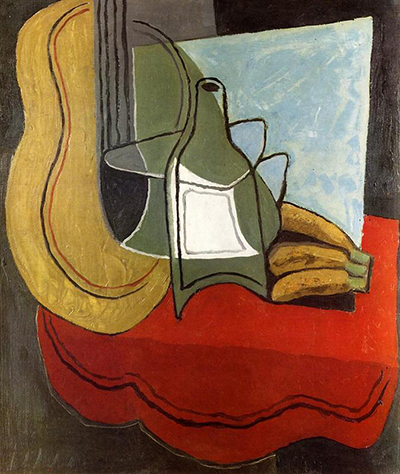Bananas is a still life painting from 1926 that was produced by Cubist painter, Juan Gris.
The standard elements of Cubist still life paintings are all present and correct in this composition. You will find the guitar, the table covered by a cloth, the fruit and also a glass bottle. These elements were also common in the work of Braque as well as the Cubist period of Picasso. This particular painting is not as far from reality as some of Juan Gris' other Cubist pieces, where on some occasions there would be so many fractured parts of the scene that it would hard to distinguish anything unless you have a prior knowledge of the artist's career.
A large rectangle of blue appears to signify light flooding into the scene from the right hand side, which then envelopes the items on the table, impacting their own tones just as you would see in the much more measured impressionist paintings from Claude Monet, such as with his series on Rouen Cathedral and the Haystacks. Gris himself uses light to provide additional angles to his scene, such as with how the table cloth hangs over the edge of the table nearest to the viewer. Besides the central part of the painting, the rest of the scene is completely bare, darkened to allow the brightness of the central pieces to appear even brighter and also take the full focus of your interest.The
The bananas, on which the painting is titled, sit nestled together on the table. There are three of them in total. Lines are then used to add some extra detail, such as the outline on the guitar, a simple pattern on the tablecloth and also a little element of interest on the glass bottle. Most of these are dark grey or black but are second line on the guitar is delivered in red - probably the same tones as used elsewhere on the cloth. Gris would not overuse palettes in his work, generally being satisfied with a limited set of colours to construct his artworks.




